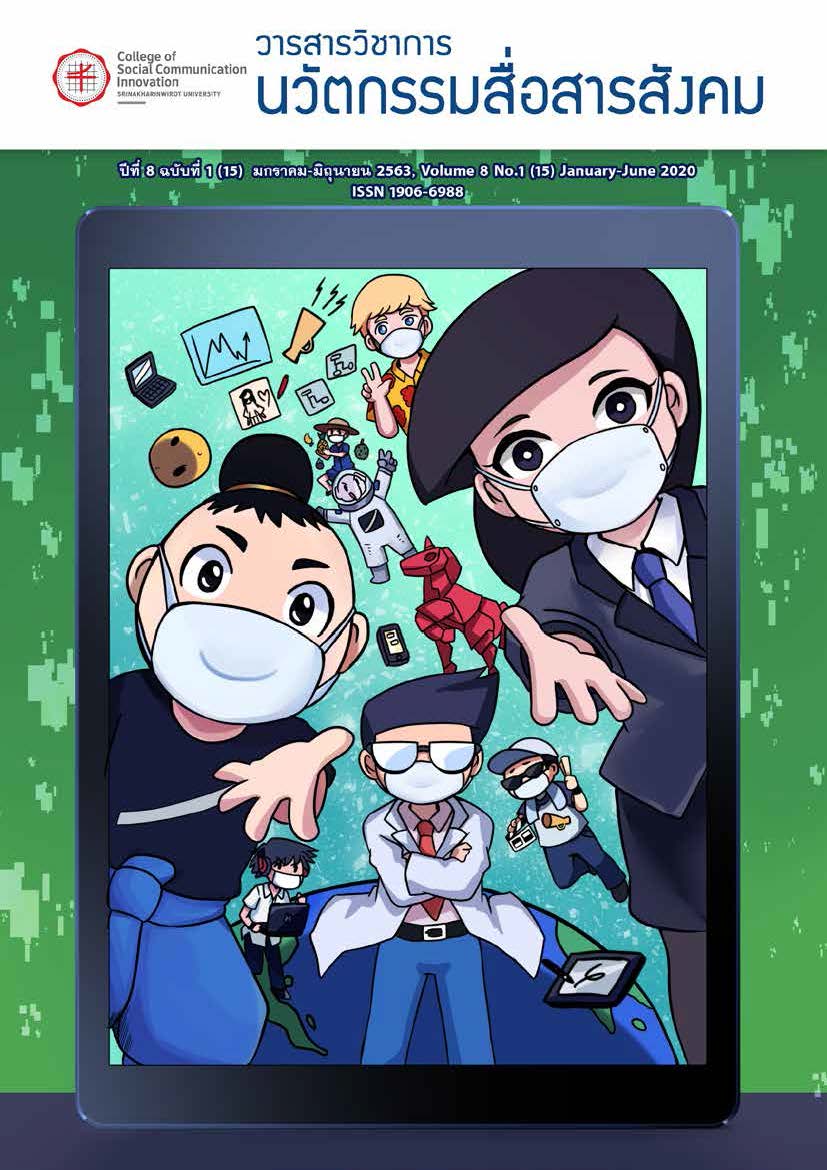วิธีวิทยาแบบชาติพันธุ์วรรณาดิจิทัล : วิธีการในการศึกษาพื้นที่เสมือน
คำสำคัญ:
วิธีวิทยา, ชาติพันธุ์วรรณาดิจิทัล, ชาติพันธุ์วรรณาแบบดั้งเดิม, พื้นที่เสมือนบทคัดย่อ
วิธีวิทยาแบบชาติพันธุ์วรรณาดิจิทัลได้รับการพัฒนา ปรับปรุง ต่อยอดมาจากวิธีวิทยาแบบชาติพันธุ์วรรณาแบบดั้งเดิม โดยนักวิชาการและนักปราชญ์หลายท่าน หนึ่งในนั้นคือProfessor Robert V Kozinets ซึ่งได้รับการยอมรับว่าเป็นผู้คิดค้นแนวคิดด้าน Netnography รวมทั้งเป็นนักวิชาการด้านเครือข่ายสังคมออนไลน์และสาขาการตลาด ซึ่งใช้ศึกษา ความเชื่อ วัฒนธรรม ปฏิสัมพันธ์ทางสังคม และพฤติกรรมของสังคมขนาดเล็กที่เกี่ยวข้องกับการมีส่วนร่วมและการสังเกตการณ์ “ตามที่เป็นอยู่” แตกต่างกันตรงที่สามารถเข้าถึงพื้นที่ภาคสนามที่หลากหลายเพิ่มขึ้นและมากขึ้น รวมทั้งมีความหลากหลายในการสื่อสาร สามารถการเชื่อมต่อการสื่อสารข้ามหลายรูปแบบ และเก็บข้อมูลได้อย่างถาวร และที่สำคัญผู้วิจัยมีหน้าที่ในการไม่รบกวนสนามวิจัย รวมทั้งการรักษาความลับของผู้ร่วมวิจัยผ่านจริยธรรมวิจัยในมนุษย์ ซึ่งเป็นประเด็นที่สำคัญที่สุดของการศึกษาผ่านวิธีวิทยาแบบชาติพันธุ์วรรณาดิจิทัล
เอกสารอ้างอิง
บุญเลิศ วิเศษปรีชา. (2546). เปิดพรมแดน : โลกของคนไร้บ้าน. วิทยานิพนธ์สาขามานุษยวิทยา คณะสังคมวิทยาและมานุษยวิทยา มหาวิทยาลัยธรรมศาสตร์
บุปผา ศิริรัศมี, จรรยา เศรษฐบุตร และเบญจา ยอดดำเนิน-แอ็ตติกจ์. (2544). จริยธรรมสำหรับการศึกษาวิจัยในคน=Ethical issues in research involving human subjects. เอกสารวิชาการหมายเลข 258. นครปฐม: สถาบันวิจัยประชากรและสังคม.มหาวิทยาลัยมหิดล
เบญจรงค์ ถิระผลิกะ. (2560). ชายรับชาย: ความสัมพันธ์ของชุมชนในทวิตเตอร์. วารสารวิชาการนวัตกรรมสื่อสารสังคม (สาขามนุษยศาสตร์และสังคมศาสตร์) วิทยาลัยนวัตกรรมสื่อสารสังคมมหาวิทยาลัยศรีนครินทรวิโรฒ. 5(2), 69-80.
เบญจรงค์ ถิระผลิกะ. (2562, 19 สิงหาคม). ภาพลักษณ์เชิงวัตถุของก้นเพศชายกามารมณ์ออนไลน์ของกลุ่มชายรับชายในทวิตเตอร์. ศูนย์มานุษยวิทยาสิรินธร (องค์การมหาชน) สืบค้นเมื่อ 20 พฤศจิกายน 2562, จาก https://www.sac.or.th/main/th/article/detail/98
วิลาสินี พนานครทรัพย์. (2018). วิธีการวิจัยเชิงชาติพันธุ์วรรณาในชุมชนออนไลน์. Thammasat University Journal, 36(2), 58-77.
อัศวิน แสงพิกุล. (2556). จริยธรรมการวิจัย. วารสารสุทธิปริทัศน์, 27(81), 137-148
Androutsopoulos, J. (2008). Potentials and limitations of discourse-centred online ethnography. Language@ internet, 5(8).
Apichayakul, O. S. (2014). Uncovering Camwomen: an ethnographic study of young Thai women who portray themselves sexually explicitly in online webcam chatrooms. Loughborough University.
Barber, K. (2007). The anthropology of texts, persons and publics. Cambridge University Press.
Beaulieu, A. (2004). Mediating ethnography: objectivity and the making of ethnographies of the internet. Social epistemology, 18(2-3), 139-163.
Bengtsson, S. (2014). Faraway, so close! Proximity and distance in ethnography online. Media, Culture & Society, 36(6), 862-877.
Benveniste, A., & Berry, G. (1991). The synchronous approach to reactive and real-time systems. Proceedings of the IEEE, 79(9), 1270-1282.
Berry, D. (2011). The computational turn: Thinking about the digital humanities. Culture machine, 12.
Boonwang, S. (2013). Background Behavior among The Elderly with Alzheimer’s Disease. Journal of Community Development Research (Humanities And Social Sciences), 4(1), 118-128. Retrieved from http://www.journal.nu.ac.th/JCDR/article/view/308
British Sociological Association. (2002). Statement of ethical practice for the British Sociological Association: British Sociological Association.
Bryman, A. (2004). Social Research Methods. Oxford, UK: Oxford University Press.
Correll, S. (1995). The ethnography of an electronic bar: The lesbian cafe. Journal of contemporary ethnography, 24(3), 270-298.
Denzin, N. K., & Lincoln, Y. S. (Eds.). (2011). The Sage handbook of qualitative research. Sage.
Dong, J., & Blommaert, J. (2009). Space, scale and accents: Constructing migrant identity in Beijing.
Ebo, B. L. (Ed.). (1998). Cyberghetto or cybertopia?: race, class, and gender on the Internet. Greenwood Publishing Group.
Garcia, A. C., Standlee, A. I., Bechkoff, J., & Cui, Y. (2009). Ethnographic approaches to the internet and computer-mediated communication. Journal of contemporary ethnography, 38(1), 52-84.
Gatson, S. N., & Zweerink, A. (2004). Ethnography online: ‘Natives’ practising and inscribing community. Qualitative Research, 4(2), 179-200.
Hammersley, M., & Atkinson, P. (1994). Etnografía: métodos de investigación. Paidós,.
Herring, S. C. (2004). Cmputer-mediated discourse analysis. Designing for virtual communities in the service of learning, 338-376.
Herring, S. C. (2004). Slouching toward the ordinary: Current trends in computer-mediated communication. New media & society, 6(1), 26-36.
Hine, C. (2000). Virtual ethnography.Sage.
Hymes, D. (2003). Ethnography, linguistics, narrative inequality: Toward an understanding of voice. Taylor & Francis.
Katz, J., & Csordas, T. J. (2003). Phenomenological ethnography in sociology and anthropology. Ethnography, 4(3), 275-288.
Kellehear, A. (1993). The unobtrusive researcher: A guide to methods. Allen & Unwin.
Kozinets, R. V. (2002). The field behind the screen: Using netnography for marketing research in online communities. Journal of marketing research, 39(1), 61-72.
Kozinets, R. V. (2007). Netnography. The Blackwell Encyclopedia of Sociology, 1-2.
Kozinets, R. V. (2010). Netnography: Doing ethnographic research online. Sage publications.
Kozinets, R. V., Dolbec, P.-Y., & Earley, A. (2014). Netnographic analysis: Understanding culture through social media data. The SAGE handbook of qualitative data analysis, 262-276.
Lee, R. M. (2000). Unobtrusive methods in social research. Open University Press.
MacKenzie, K. E. (1994). The foraging behaviour of honey bees (Apis mellifera L) and bumble bees (Bombus spp) on cranberry (Vaccinium macrocarpon Ait). Apidologie, 25(4), 375-383.
Marotzki, W., Holze, J., & Verständig, D. (2014). Analysing virtual data. The SAGE handbook of qualitative data analysis, 450-463.
Murthy, D. (2008). Digital ethnography: An examination of the use of new technologies for social research. Sociology, 42(5), 837-855.
Naidoo, L. (2012). Ethnography: An introduction to definition and method. An ethnography of global landscapes and corridors, 1-8.
O'reilly, K. (2012). Ethnographic methods. Routledge.
Oxfordbibliographies. (2017). Selective Exposure. Retrieved 5 august 2019, from https://www.oxfordbibliographies.com/view/document/obo-9780199756841/obo-9780199756841-0164.xml
Postill, J., & Pink, S. (2012). Social media ethnography: The digital researcher in a messy web. Media International Australia, 145(1), 123-134.
Reeves, S., Kuper, A., & Hodges, B. D. (2008). Qualitative research methodologies: ethnography. Bmj, 337, a1020.
Roberts, L., Smith, L., & Pollock, C. (2004). Conducting ethical research online: Respect for individuals, identities and the ownership of words. In Readings in virtual research ethics: Issues and controversies (pp. 156-173). IGI Global.
Robinson, L., & Schulz, J. (2009). New avenues for sociological inquiry: Evolving forms of ethnographic practice. Sociology, 43(4), 685-698.
Rosen, M., & Touyz, L. Z. G. (1991). Influence of mixing disinfectant solutions into alginate on working time and accuracy. Journal of dentistry, 19(3), 186-188.
Roulston, K. (2014). Analysing interviews. The SAGE handbook of qualitative data analysis, 297-312.
Ruhleder, K. (2000). The virtual ethnographer: Fieldwork in distributed electronic environments. Field Methods, 12(1), 3-17.
Samakkeekarom, R., & Boonmongkon, P. (2011). Cyberspace, power structures, and gay sexual health: the sexuality of Thai men who have sex with men (MSM) in the Camfrog on-line web-cam chat rooms.
Sanders, T. (2005). Researching the online sex work community. Virtual methods: Issues in social research on the Internet, 67-79.
Shum, K. F. (2014). Self-presentation and Impression Formation through Photographs in an LGBT Online Dating Community.
Sirisawat Apichayakul, O. (2014). Uncovering Camwomen: an ethnographic study of young Thai women who portray themselves sexually explicitly in online webcam chatrooms. Doctoral dissertation Ph.D., Loughborough University.
Zhao, S. (2005). The digital self: Through the looking glass of telecopresent others. Symbolic interaction, 28(3), 387-405.
ดาวน์โหลด
เผยแพร่แล้ว
รูปแบบการอ้างอิง
ฉบับ
ประเภทบทความ
สัญญาอนุญาต
บทความทุกบทความที่ได้รับการตีพิมพ์ถือเป็นลิขสิทธิ์ของวารสารวิชาการนวัตกรรมสื่อสารสังคม มหาวิทยาลัยศรีนครินทรวิโรฒ







